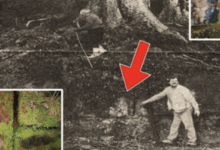5 Mysterious Artifacts That Are Out-Of-Place and Out-Of-Time
5 Mysterious Artifacts That Are Out-Of-Place and Out-Of-Time
The London Hammer
On a summer afternoon in 1936, Max Hahn and his wife were walking along Red Creek near London, Texas, when they discovered something unusual—a piece of wood protruding from a chunk of rock. What they found would later become one of archaeology’s most controversial artifacts: a hammer that some claim challenges our understanding of human history.
It wasn’t until a decade later that the Hahn family broke open the stone, revealing a hammer encased inside. At first glance, the tool appeared ordinary—an iron head measuring six inches with a wooden handle, resembling those used by 19th-century miners. However, analysis of the hammer’s metal composition revealed it to be 96.6% pure iron, a level of refinement some argue was impossible with 19th-century technology. Adding to the mystery, part of the wooden handle appeared to be fossilized.
The biggest controversy, however, revolves around the rock encasing the hammer. The surrounding limestone concretion has been variously dated to the Cretaceous, Ordovician, and Silurian periods—hundreds of millions of years before humans supposedly existed.
In 1983, creationist Carl Baugh acquired the hammer and promoted it as evidence of an advanced pre-Flood civilization. Despite numerous requests, the wooden handle has never undergone full carbon dating. However, a limited test in the late 1990s suggested the wood was no more than 700 years old.
Geologists offer a simpler explanation: the hammer was likely dropped by a frontier craftsman in the 19th century. Over time, mineral-rich water seeped around it, forming a natural concretion—a process that has similarly encased World War II artifacts in stone within mere decades.
Today, the London Hammer remains on display in a museum, its mystery unresolved. While evidence strongly suggests it is a relatively modern artifact, definitive answers remain elusive unless further testing is allowed.
The Dorchester Pot
In 1851, a massive explosion shook Meeting House Hill in Dorchester, Massachusetts, as workers blasted through rock. When the dust settled, they made a bizarre discovery—an intricately designed metal vessel buried within the shattered stone.
The artifact, later called the Dorchester Pot, was a bell-shaped metal vessel, about 4.5 inches tall, made of a zinc-silver alloy. It featured delicate floral and vine inlays in pure silver, with a decorative wreath encircling its base.
What made the find extraordinary was its reported origin. The workers claimed the pot had been embedded in puddingstone dated between 570 and 593 million years old—a time when the only life on Earth consisted of simple marine organisms.
The story, reported in Scientific American in June 1852, sparked intense debate. Some suggested it was evidence of an advanced lost civilization, while others wove it into biblical narratives, linking it to a great flood that reshaped the Earth.
However, archaeologists have a different take. Keith Fitzpatrick-Matthews argues the pot was found loose in the explosion debris rather than embedded in solid rock. Moreover, its design is distinctly Victorian, resembling candlesticks and pipe holders from the 19th century. Italian researcher Bajio Catalano even identified a nearly identical Indian pipe holder in a Mumbai museum.
Adding to the mystery, the Dorchester Pot vanished shortly after its discovery. Only written accounts and a single, questionable photograph remain, leaving its true origins a matter of endless speculation.
The Nampa Figurine
In July 1889, a well-drilling crew in Nampa, Idaho, unearthed a tiny clay figurine at a depth of over 300 feet. The object, just 1.5 inches tall, was shaped like a woman with visible markings resembling jewelry and clothing.
The layer where it was found was reportedly 2 million years old, far older than the earliest known humans in North America—let alone their ability to craft such figures.
Some scientists, like geologist George Frederick Wright, defended its authenticity, arguing that floods and volcanic activity could have buried it deep underground over time. However, others were skeptical. John W. Powell, a leading geologist, dismissed it as a 19th-century Native American doll, possibly made by the Pocatello tribe. Locals even joked that it was a hoax meant to fool outsiders unfamiliar with the region’s history.
Later investigations raised further doubts. Archaeologist Keith Fitzpatrick-Matthews found that similar iron-stained clay objects were located at much shallower depths, suggesting that geological shifts—or the drilling process itself—could have displaced the figurine.
Despite the skepticism, creationists continue to cite the artifact as evidence of a much older human history. Today, the Nampa Figurine is housed at the Idaho State Historical Society Museum, surrounded by unanswered questions.
The Coso Artifact
In February 1961, three amateur rock collectors exploring the Coso Mountains of California made a discovery that would baffle archaeologists for decades.
The following day, as one of them cut open a suspected geode, they found something bizarre inside: a perfectly cylindrical piece of porcelain with a metal shaft, all encased within a hardened rock-like material.
Named the Coso Artifact, the object quickly gained attention. The metal shaft was magnetic, the porcelain appeared man-made, and the outer casing reportedly contained fossil shells—suggesting an age of at least 500,000 years.
Some believed it to be evidence of an ancient civilization or even extraterrestrial technology. Creationists argued that it disproved mainstream archaeology. Wallace Lane, one of the discoverers, refused to allow closer examination and even priced it at $25,000, equivalent to a small fortune at the time.
However, in 1999, researchers Pierre Stromberg and Paul Heinrich took a different approach. They showed X-rays of the object to members of the Spark Plug Collectors of America—who immediately identified it as a 1920s Champion spark plug, the type used in Model T Ford engines.
A later 2018 geological analysis confirmed the identification and debunked earlier claims about the fossil shells. Today, the Coso Artifact is displayed at Seattle’s Pacific Science Center in an exhibition titled What Is Reality?—a fitting home for one of archaeology’s strangest cases.
The Aiud Wedge
In 1973, construction workers near the Mureș River in Romania made a puzzling discovery while digging 33 feet underground. Alongside two fossilized mastodon bones, they found a strange metal object with an unknown origin.
Measuring 8 inches long and 5 inches wide, the Aiud Wedge was composed of 90% aluminum, with traces of 11 other metals. It was lightweight and bore concave depressions, suggesting it had once been part of a larger mechanical system.
Initial tests dated the artifact to at least 250,000 years ago—a timeframe that contradicts known human history, as aluminum production only began about 200 years ago.
Some quickly labeled the artifact as proof of extraterrestrial technology, claiming it was a fragment of a crashed UFO. The Romanian government reportedly kept its discovery secret during the communist era, adding to the mystery.
However, metallurgical analysis in later decades suggested a more mundane explanation: the Aiud Wedge was likely a piece of 20th-century aviation equipment, possibly part of a landing gear or aircraft component. Its aluminum composition and weathering indicated long-term burial, but nothing beyond a few decades.
Despite the scientific consensus, conspiracy theories persist, and the Aiud Wedge remains one of the most debated out-of-place artifacts in history.




